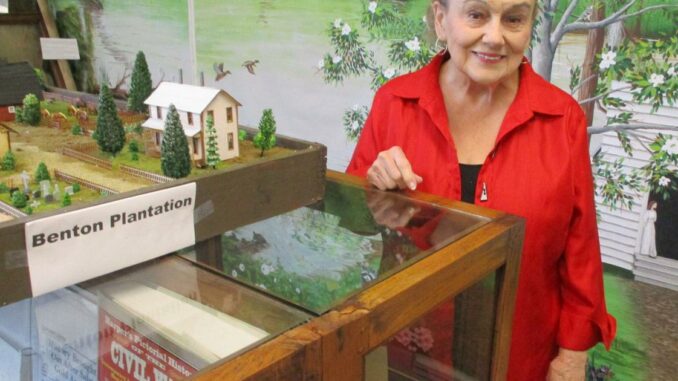
Members of the Edward L. Livingston Historical Association learned about Denham Springs and the surrounding area at the group’s March 2 meeting at Old City hall Museum on Mattie Street in the city’s historic downtown area.
Association members were given a tour of the museum before gathering in the upstairs meeting room to hear a discussion on the history of Denham Springs from Kathleen Dawkins, who has made a hobby of studying the history and development of Livingston Parish’s largest city and the heart of the area’s commercial trade.
Introducing the day’s program was Eric Edwards, executive director of the Livingston Parish Convention and Visitors Bureau. Edwards said history is a major part of tourism and helps to market the communities in Livingston Parish.
“We are a parish that represents a wide range of demographics and visitors are interested in learning all about our people and where we came from. They get off the interstate and ask about our people and how they can learn more about who we are while visiting the area,” Edwards said.
“The French settled here and left the legacy of French Settlement. For a number of years, this was Spain’s territory and the Spanish moved in. Over time, settlers from the original 13 colonies of the newly formed United States became our main citizens. The nation’s largest rural Hungarian settlement is here in Livingston Parish. Many others have made this wonderful place their home,” he said.
‘Not an Acadian community’
Dawkins prefaced her lecture by declaring, “We are not an Acadian community. Visitors from other states ask if we are Cajun and I have to tell them that we are not … we have French connections in Livingston Parish, but we were mainly settled by English speaking families who settled here largely following the American Revolution.”
Kathleen Dawkins, longtime Denham Springs resident who maintains an interest in the city’s and the area’s history, stands next to a display of the Robert Benton plantation, one of the earliest, and most prosperous settlements in the Denham Springs area. She addressed a recent meeting of the Edward Livingston Historical Association held at the Old City Hall Museum in Denham Springs.
Dawkins said Livingston Parish was not a part of the Louisiana Purchase as out-of-state visitors sometimes assume. She explained that at the time of the purchase, present day Livingston Parish and the other part of Louisiana east of the Mississippi River, with the exception of New Orleans, was Spanish West Florida Furthermore, for a very brief time this area was known as the Republic of West Florida.
Dawkins said she has learned that visitors to the area want to know about the people. “I find that visitors want to know you That is one reason why we have the museum here in Denham Springs. This museum helps to tell the story of who we are as a people. This museum is filled with pictures and stories of who we are, where we came from and what we have accomplished,” she said.
Old city hall turned into museum
The building that now houses the Old City Hall Museum was built in 1939-40 as part of the Works Progress Administration initiative started by President Franklin D. Roosevelt. Dawkins said that when the building opened for business in late 1940 it housed the mayor’s office, the police department, the town library, the office of motor vehicles where driver’s license could be obtained and a jail.
“This building even has a basement … the government just could not conceive of a building without a basement. It has stayed pretty dry considering our Louisiana climate,” she said.

Members of the Edward Livingston Historical Association gather in Old City Hall Museum in Historic Downtown Denham Springs for the group’s March meeting. Kathleen Dawkins, at end of table, talks on the history of the museum and Denham Springs to the group. Clark Forrest, president of the association, is at right.
Discussing the jail, still a part of the museum today, Dawkins said, “when I was a young girl, you could walk by here and the prisoners would be sitting on the front porch smoking cigarettes. There was no one guarding them; when they were finished, they would go back inside.” She also recalled that in her youth Denham Springs was under the threat of a hurricane so her father moved the family into the City Hall for safekeeping until the storm passed.
“They used a lot of concrete building the City Hall so it was a safe place to be,” she related.
In the early 1970s, a new City Hall was built and the old building was largely abandoned. In subsequent years, Main Street Denham Springs volunteers, led and encouraged by local sign painter and artist Lionel Kabel, decided to restore the building and establish a museum. Their work, Dawkins said, has come to be the museum that it is today.
She said the museum largely reflects life in Denham Springs and the surrounding area. The Research Room in the museum is the repository of numerous collections contributed by residents over the years.
Museum filled with stories of the past
“We have records and stories about churches, schools, family associations, legal documents. Some of the stories are happy and some sad but all represent facets of the lives led by our people,” she said.
Part of the museum is dedicated to Robert Benton, an early pioneer in the area who established a plantation on the Amite River where he also started a ferry service. “Robert Benton was a farmer, a politician, a developer and left a legacy marked by many accomplishments. He lost three sons in the Civil War. We honor him as one of the most important founders of our city,” Dawkins said.
The museum also contains information and exhibits showing contributions made by Livingston Parish residents who served in the nation’s military over the years.
Dawkins ended her talk by relating what she called one of the happier times in the city’s history. She said that a music teacher acquired the music room from the Denham Springs Collegiate Institute, an early center of learning in the community. She said that hall, approximately 50 by 100 feet large, became the social center of the town.
“People would come from all over to listen to music and dance. I heard stories that they would wax and powder the floor for the dancers. This was a happy time and it is reported that as many as 300 people would show up for the dances. The neighbors would lean out of their windows to listen to the music and the laughter and joy of the dancers. This was a fanciful time in the city’s history,” she said.
Following the lecture, Donna Jennings, executive director of Main Street Denham Springs, led the group on a tour of the nearby Antique Village.



Leave a Reply